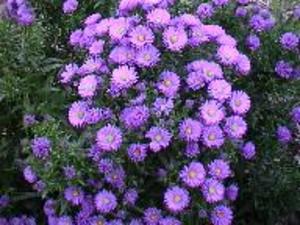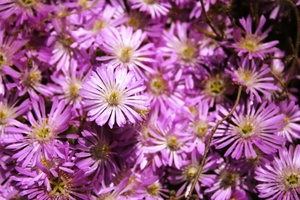Asters, also known as “starwort,” are hardy and colorful choices for your fall garden. These brilliantly colored flowers bloom from August through October, and were chosen as the official birth flower for September. In some locations they can grow till Christmas!
Asters feature more than 600 species of the Compositae family. The name “aster” originates from the Greek word for star, “astron” and draws its basis from the shape of the flower’s head.
Some of the more popular types of asters are: the New England Aster, the Michaelmas Daisy (also called New York aster), the Sea Aster, the Monte Casino, the Frost Aster, and the Heath Aster. Michaelmas Daisy is commonly used to describe any early fall blooming aster.
Where are Asters Grown?
Asters are grown worldwide, from North America to China, across Europe, Japan and Siberia. It is thought that the European asters were first cultivated in France. Many of the modern cultivated North American asters are native to Canada, from Newfoundland to British Columbia.
Asters flourish in full sun, but they are also known for tolerating partial shade well, and so can be successfully grown in many seemingly disparate locations. Although they are widely thought to prefer cool, moist temperatures,some varieties do grow in very dry desert conditions. In fact, there is a named Desert Aster that is found in Colorado and the Mojave Desert, and is quite common in the Joshua Tree National Park.
If the weather is very cold, some asters can be lost to early frosts, but most varieties of this plant are very tough.
The History and Lore of Asters:
The aster’s origination can be traced back to over 4000 years ago in China. It has been documented in Europe for at least 400 years.
In ancient times, asters were believed to ward off serpents and evil spirits with their odor when their leaves were burned. A myth related that when Virgo looked down from heaven and wept, the stardust combined with his tears to create the aster. Virgil wrote that asters adorned the altars of the gods. Thus they were known as divine emblems in their early history.
Medicinal Uses:
Asters have been used in Chinese medicine for more than two thousand years. They mainly are used in cases of lung disease such as tuberculosis, bronchitis, staph infections, typhoid, and whooping cough. Their curative powers are said to include antibiotic, expectorant, and antifungal capabilities. The aster’s root is sometimes mixed with honey and taken internally to heighten the expectorant quality.
The aster plant has also been used in alternative cancer treatment, as it contains epifriedelinol, a plant oil which has been shown to be an effective anticancer agent.
Choosing,Planting and Caring for the Aster:
You will want to locate the varieties of aster that are the most resistant to disease, as sometimes the aster is prone to powdery mildew and rust. The most disease-resistant asters are usually dwarf dumosis hybrids, aster ericoides, and Aster X. Frikartii, or “Moench.” You can also consult your local nursery to see which are the most hearty varities in your particular locale. Remember that overcrowding of the plants and not enough sun often promotes mildew.
Asters should generally be planted in the spring season. For most varities you will want to select a spot with plenty of full sun. Do not plant the asters too close to buildings or fences, as you want plenty of air cirulation around and through your aster growth.
You will want to loosen the soil in your garden a foot or so in depth, and mix in a couple of inches of compost or fertilizer. Remember to only fertilize early in the season. (When the plants are flowering, you will want to withhold further fertilization or you will end up with too much plant and too little flowering.) The plants should be placed one to three feet apart. The holes you place them in should be twice as big as the plant pot provided. Put the root ball level with the top of the soil. Then fill in the hole around the root ball and water the plant.
If you have planted taller asters, you will need to pinch them back or prune them to half their height around the middle of June or later. Cut the stem above the leaves.
You should probably divide the aster plants every couple of years, as well as weeding and taking out older clumps. You can retain seedlings for replanting in the spaces where you have removed plants which have exhausted. For most varieties, you will want to keep the ground moist.
If your plant does develop mildew, your nursery should be able to provide you with a fungicide of wettable sulfur. The fungicide can also be used once a week to prevent mildew.
Special Features of the Aster:
Asters are a desirable flower not only because of the bright rainbow of colors you can find them in — pinks, purples, blues, violets, magentas, reds, pastels — but also because they are well known for attracting butterflies.
If you want a picture-perfect bright perennial fall garden, consider the durable aster in all its brilliant glory!




